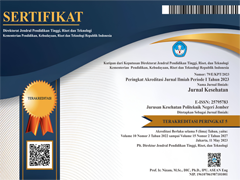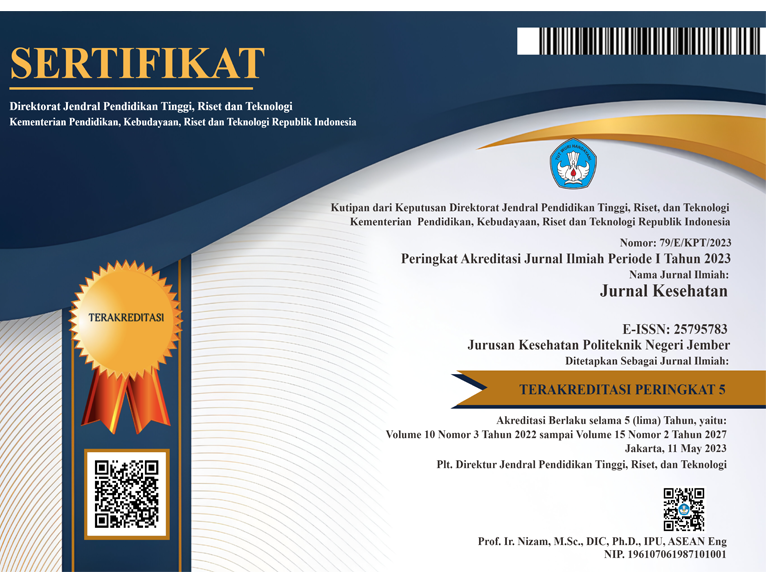Analisis SIMRS Dengan Metode PIECES Di RSU Dr. H. Koesnadi Bondowoso
DOI:
10.25047/j-kes.v8i2.155Downloads
Abstract
Hospital Information System (HIS) is an important component to improve hospital service quality. HIS at General Hospital Dr. H. Koesnadi Bondowoso has been running for about 5 years since 2015. HIS implementation is not optimal because there are still various problems in its implementation. The problem such as errors in printing reports so users must create reports manually. This research was aimed to analyze the application of hospital information systems using the PIECES method. This type of research is qualitative. It showed that the information Hospital Information System (HIS) performance results based on aspects of performance Hospital Information System (HIS) performance goes according to user needs, information aspects of information generated accurately, aspects of economics have produced economic value, running control aspects related to control and system security, efficiency aspects have provided efficiencies in its application, service aspect has made it easy for system users. Based on aspects of Performance, Information, Economic, Control, Efficiency, and Service Hospital Information System (HIS) performance has been running according to user needs, but it is not free from various problems, so there needs a efforts to improvement and development of Hospital Information System (HIS) through the recommendation of researchers so that Hospital Information System (HIS) can maintain quality and improve service quality to patients.
Keywords:
hospital, hospital information system, PIECES methodReferences
Anggraini, N. (2017). Evaluasi Sistem Informasi Manajemen Rumah Sakit (SIMRS) dengan Metode End User Computing Satisfication (EUCS) di Rumah Sakit Djatiroto PT Nusantara Sebelas Medika Lumajang. Politeknik Negeri Jember.
Ayuninghemi, R., & Deharja, A. (2017). Pengembangan Layanan Aplikasi E- Konsul. 266–272.
Deharja, A and Santi, M. (2018). The evaluation of hospital information system management based on hot-fit model at rsu dr . h . koesnadi bondowoso 2018. 486–490.
Deharja, A. & Permatasari, V. (2016). Implementasi Sms Gateway Untuk Meningkatkan Jumlah Kunjungan Di Posyandu Catleya 14 Jember. 1(2), 168–171.
Deharja, A. & Permatasari, V. (2016). Peningkatan Pengetahuan dan Kreatifitas Kader Melalui Pemanfaatan Teknologi SMS Gateway Untuk Mengoptimalkan Kunjungan Posyandu. 224–227.
Dinkes Provinsi Jatim. (2018). Profil Kesehatan ProvinsiJawa Timur Tahun 2018. Retrieved from https://dinkes.jatimprov.go.id/userfile/dokumen/Buku Profil Kesehatan Jatim 2018.pdf
Djahir, Y. (2014). Sistem Informasi Manajemen. Yogyakarta: Deepublish.
Erawantini, F., Deharja, A., & Yusfitasari, Y. (2016). Analisis Kesiapan Penerapan Sistem Informasi Manajemen Puskesmas ( Simpus ) Dengan Metode Doq-It Di Puskesmas Wonotirto Kabupaten Blitar Tahun 2016. 4(1).
Handiwidjojo. (2013). Sistem Informasi Manajemen Rumah Sakit. Wordpress. Retrieved from https://rusdinncuhi.wordpress.com/2013/07/04/makalah-sistem-informasi-manajemen-rumah-sakit/.
Hanif, A. (2019). Sistem Informasi Sederhana Menggunakan Spreadsheet dan Macro Untuk Usaha Mikro Informal. Seminar Nasional Teknologi Komputer & Sains (SAINTEKS), 1(1), 851–855. Retrieved from https://www.prosiding.seminar-id.com/index.php/sainteks/article/view/241.
Himss. (2013). EHR Adoption Model. Retrieved from https://www.imprivata.com/sites/default/files/resource files/Imprivata_HIMSS_Analytics_Streamlining_Workflows.pdf.
Karimah, R. N., Setiawan, D., & Nurmalia, P. S. (2016). Diagnosis Code Accuracy Analysis Of Acute Gastroenteritis Disease Based on Medical Record Document in Balung Hospital Jember. Journal of Agromedicine and Medical Sciences, 2(2), 12. https://doi.org/10.19184/ams.v2i2.2775
Maya Weka Santi, A. D. (2020). Analisis Kendala Penggunaan Sistem Informasi JSC with FAI di Kabupaten Jember berdasarkan. 11, 84–90.
Mudiono, H. B. (2018). Dampak Kualitas Sistem, Pengguna Sistem dan Organisasi dalam Pemanfaatan Kinerja Sistem Informasi Manajemen Rumah Sakit di RSU Dr. H. Koesnadi Bondowoso. Multidisciplinary. Retrieved from http://repository.unej.ac.id/handle/123456789/88987.
Murnita, R. (2014). Evaluasi Kinerja Sistem Informasi Manajemen Farmasi di RS Roemani Muhammadiyah Dengan Metode Hot Fit. Jurnal Manajemen Kesehatan Indonesia, 04(01), 2013–2014. Retrieved from https://www.neliti.com/id/publications/112501/evaluasi-kinerja-sistem-informasi-manajemen-farmasi-di-rs-roemani-muhammadiyah-d
Santi, M. W., & Deharja, A. (2020). The Effect Of Information System Usability And Midwife Involvement Toward Perceived Usefulness Of Jember Safety Center ( Jsc ) With Fai In Jember Regency. The Second International Conference on Food and Agriculture, 277–281.
Sugiyono. (2007). Metode Penelitian Kuantitatif Kualitatif dan R & D. Bandung: Elfabeta.
License
Authors who publish in this journal agree to the following terms:
1. Copyright belongs to the medical journal as a publication
2. The author retains copyright and grants the journal rights to the first publication carried out simultaneously under a Creative Commons Attribution License which allows others to share the work with an acknowledgment of the author's work and initial publication in this journal.
3. Authors may enter into separate additional contractual arrangements for the non-exclusive distribution of the work (eg sending it to an institutional repository or publishing it in a book) with acknowledgment of initial publication in this journal.
4. Authors are permitted and encouraged to post work online (eg in institutional repositories or on their websites) before and during the submission process, as before and larger citations of published work (see Effects of Open Access).
Selengkapnya tentang teks sumber ini














